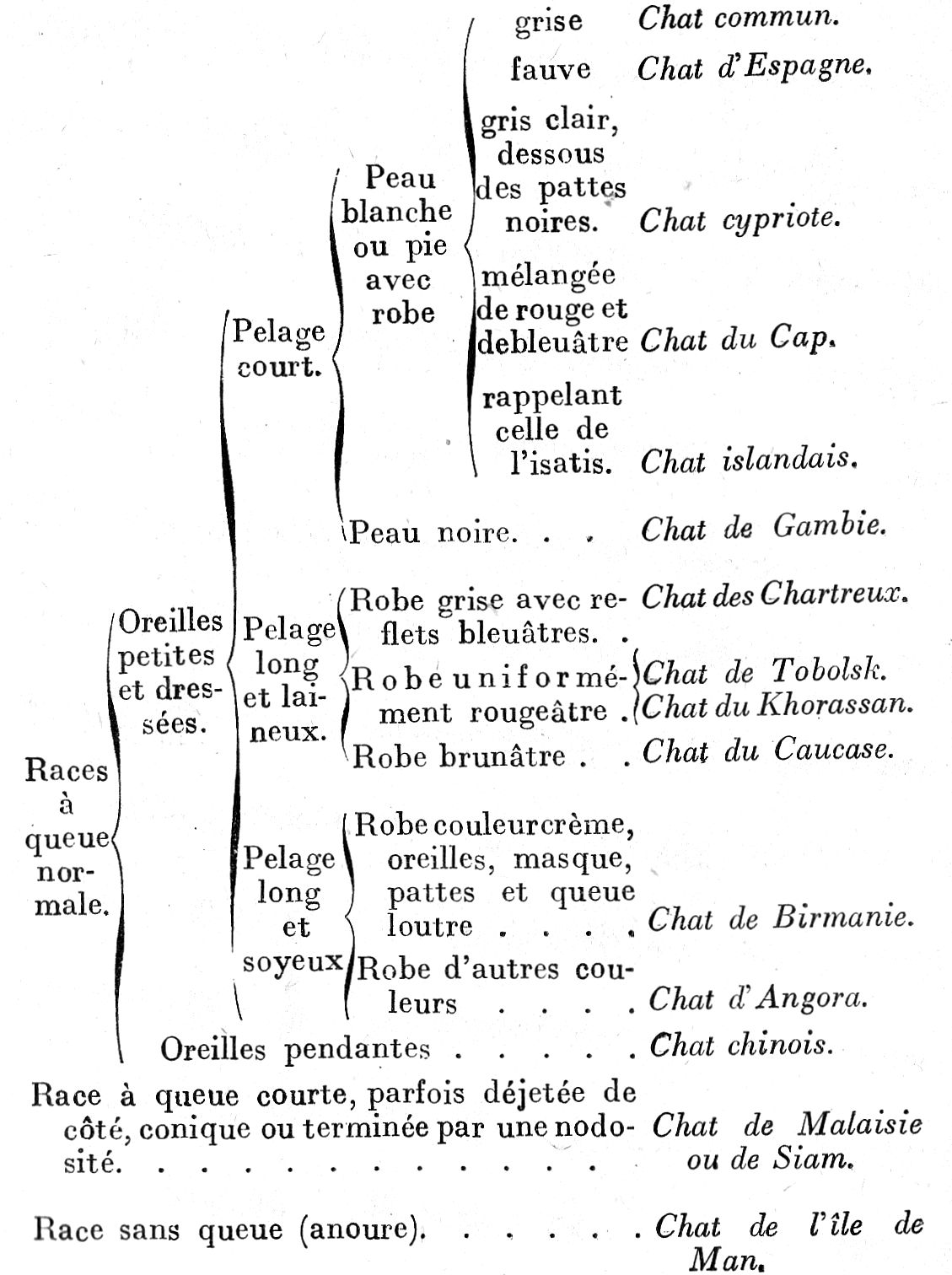
BREEDS OF CATS
LYON NATIONAL VETERINARY SCHOOL
School year 1924 1925. - No. 15
BREEDS OF CATS
Thesis presented at the Faculty of Medicine and Pharmacy of Lyon
And supported publicly on March 25, 1925 to obtain the rank of Veterinary Doctor
PHILIPPE JUMAUD
Born May 6, 1880 in St Etienne (Loire)
Edition des Tablettes
Saint-Raphael
1925
TEACHING STAFF AT LYON VETERINARY SCHOOL
Director - M. F.-X LESBBE.
Honorary professor - M. Alfred FAURE, former director
PROFESSORS
Physical and medical chemistry, Pharmacy, Toxicology - MM. PORCHER
Medical and fodder botany, medical zoology, parasitology and parasitic diseases - MAROTEL.
Descriptive anatomy of domesticated animals, Teratology. Exterior - LESBRE.
Physiology, General Therapeutics, Medical material - JUNG.
Histology and Embryology, Pathological anatomy, Inspection of foodstuffs and establishments classified as subject to veterinary control - BALL.
Medical pathology of Equidae and Carnivores, Clinic.
Semiology and Preliminary instruction, veterinary case law - CADEAC
Surgical pathology of Equidae and Carnivores, Clinic.
Surgical anatomy, Operative medicine - DOUVILLE.
Bovine, ovine, caprine, porcine and avian pathology. Clinical.
Operative medicine. Obstetrics - CUNY.
General Pathology and Microbiology. Microbial diseases and clinical health policy - BASSET
Hygiene and Agronomy. Zootechnics and Rural Economy - BOUCHER
WORK MANAGERS
MM. PORCHEREL. AUGER. LOMBARD.
MM. TAPERNOUX. TAGAND.
THESIS EXAMINERS
Chairman: Dr. F. ARLOING, Professor of Experimental and Comparative Medicine and Bacteriology at the Faculty of Medicine, National Correspondent of the Academy of Medicine, Knight of the Legion of Honour.
Assessors: M. H. BOUCHER, Professor at the Veterinary School, Knight of the Legion of Honour.
M. C. CADEAC, Professor at the Veterinary School. Knight of the Legion of Honour.
The Faculty of Medicine and the Veterinary School declare that the opinions expressed in the essays presented to them should be considered as specific to the authors and that the Faculty does not intend to give them either approval or disapproval.
I dedicate this work to the memory of Marguerite Jumaud
Ph. J.
ECONOMIC VALUE OF CATS.
The public's justified infatuation with dogs might suggest that the same is true of cats here. It is not so; this domestic animal is generally not the object of any solicitude, despite the services it renders and the value of certain individuals.
In England and Belgium, it is not so; luxury cat breeding is practiced by many breeders, women in general, who derive a significant income from it. Owing to the number of special clubs, to exhibitions, to public taste, the prices attained are often considerable. Animals with good pedigrees, 10 to 12 months old, commonly sell for £30 - £40 and some champions fetch prices of £100 and even £200.
There are Cat-Farms in America, and also Kitten Raising Farms where special attention is paid to the scientific breeding of expensive kittens. In France, enthusiasts who have taken an interest in cat breeding are very satisfied with the results.
Mme Brassart, whose Maritza cattery (Blue Persians) groups together several award-winning females and studs, easily sells her youngsters for 300 and 400 francs at weaning, 500 and 600 francs for cats from 5 to 10 months depending on the beauty of the individual; the animals awarded prizes at shows immediately acquire real added value and several of Mme Brassart’s cats would not be sold for less than 3,000 or 4,000 francs. 6,000 francs were paid for some animals imported from England. In 1923, Mme Brassart acquired an adult white Persian for 114 pounds which, together with the 20% customs, transport costs and luxury goods tax, represents about 12,000 francs. In September 1924, she acquired a blue she-cat which cost her 10,000 francs.
The prices of Siamese and other short-haired cats are generally lower. At weaning, ordinary subjects sell for 80 to 150 francs; from 5 to 10 months, prices stabilize between 300 and 500 francs. As for the Blue Persian, the award-winning females and studs, employed in breeding, fetch high prices: 1,500 to 3,500 francs. Some rare cats are rated very highly, they are orange, cream, tortoiseshell cats or the extremely rare Birman cats.
The breeding of pedigree cats is practiced in France by around 1,500 breeders, who, in 1924, bred an average of ten animals; if in 1925 the number of breeders increases in proportion to the last three years, it will exceed 2,000 by the end of the year.
Cat breeding is also of economic interest because, for several years, couturiers have launched "fancy" furs in which cat skins figure, not only from the tabby cat, but also from various colours of long-haired Persian and Angora, and from the Royal [Seal-point] Siamese, etc. Cat fur is used for adornment and as a warm lining, but its use is not limited to this; several large novelty stores recently exhibited car blankets made from 15 or 20 almost identical tabby-and-white cat skins, so closely matched it can be assumed that it took several hundred to find this number of matching skins.
The use of these furs has provoked protests from cat lovers, a protest currently legitimate, as it is very likely that the animals which provided the furs were stolen and slaughtered since no utilitarian breeding exists in France. But, by generalizing and protesting, the cat lovers miss the point, and since fashion, a tyrannical god to whom we must bow, calls for cat skins, we can envisage their rational production in France without misplaced sentimentality. In this we will follow America, where successful ranching farms deliver sizable financial results. There is no reason not to breed these animals for fur if they are given good care during their lives and humanely sacrificed; by breeding cats for this purpose, many small investors could increase their income as some already do by exploiting rabbits in this way.
The foregoing considerations and figures indicate that cat breeding is an element of wealth likely to be developed with the aim of reducing the importation of pedigree cats, to organize their export to countries where the pedigree cat is particularly appreciated and, finally, to use their fur.
The detailed study of feline breeds, especially luxury breeds, in the most extreme detail of their characters, expressed by standards, is therefore useful.
BREED STANDARDS
Until 1912, French authors describing the breeds of cats contented themselves with mentioning, without much detail, certain typical characteristics without considering all parts of the body. Since the foundation of the Cat Club de France, the drafting of standards has been attempted for the main breeds
In England, Miss Simpson, in "The Book of the Cat," published in 1900, published a series of standards mainly based on colour and fur type.
Their establishment is generally the consequence of the work of clubs trying to codify the beauty and the purity of the breeds which interest them. Some standards, which were drafted by serious breeders, have hardly been modified; others, published by leaders of clubs wishing to create races in order to govern them, are generally of little value.
The standards published here are those that have been drawn up by specialist registries in France or Belgium, but it is mainly in England that the breeds in this study have been described. Unfortunately, their wording is far from precise, practical and scientific.
In the interests of breeding, they should be reviewed, clarified and supplemented by a competent official committee, both technical and scientific, to which we could add long-serving breeders and show judges.
The standards should describe:
A) the general appearance of the breed.
B) the fundamental characteristics of the breed, mentioned by main parts;
C) the size, shape and weight of the animals with maximum and minimum figures, taking into account the sex of the subjects: male, female or neuter;
D) a description of the skin and coat with a precise indication of the colours, their distribution and the fixed characteristics of the coat.
With very exact standards, it will be possible to eliminate from the breeding population, or at least eliminate them from being registered in stud books, those cats not meeting the minimum standard according to its scale of points.
These official standards should be approved by the Superior Committee of Genealogical Books appointed by the Ministry of Agriculture; they would then be truly adopted by breeders in all countries who demand precise and scientific guidelines.
CLASSIFICATION OF CAT SPECIES
"Without a method," says Lesson, "no point of science, no elder’s knowledge can be passed down to his successors." This is why I think it useful to present the whole classification of the species which forms the genus Felis. This classification, like all classifications, presents some difficulties, for the typical characters of the felid species are not always distinct.
To establish a classification, it cannot be based on secondary peculiarities of the teeth and skeleton, nor the length of the tail, bristles of the hair inside the ears or, finally, on the various colourations of the coat. I have adopted, and supplemented, the classification in d’Orbigny’s Dictionary of Natural History. This separates the true cats into three sections:
FIRST SECTION – OLD WORLD CATS.
Lion (felis leo)
Panther (felis pardus)
Leopard (felis leopardus)
Serval (f. serval)
Ounce according to Buffon (f. unicia)
Black-footed Cat (f. nigripes)
Golden Cat (f. chrysotrix)
Caffre Cat (f. cafra)
Gloved Cat, (f. maniculata)
Bengal Cat (f. Bengalensis)
Rusty Spotted Cat (f. rubiginosa)
Domestic Cat (f. catus)
SECOND SECTION – NEW WORLD CATS.
Jaguar (f. onca).
Cougar (f. concolor).
Unicoloured Cat (f. unicolor).
Jaguarondi (f. yaguarundi).
Chalybe (f. chalybeata). [bobcat?]
Spotted Bellied Cat (f. Celodegaster).
Ocelot (f. pardalis).
Fettered cat (f. cateneta) [Chat Enchaine]
Tlatco Ocelot (f. pseudo pardalis).
Necklaced cat (f. Armillata)
Oceloid Cat (f. macrousa).
Chati (f. mitis)
Guigna (f. guigna)
Colocollo (f, colocollo).
Elegant Cat (f. elegant).
Margay (f. tigrina).
Negro Cat (f. nigritia).
Cat of New Spain (f. mexicana).
SECTION THREE - CATS FROM THE ASIATIC ISLE OR THE INDIAN ARCHIPELAGO.
Arimaou (Black Panther of the Naturalists),
Kurnuc (f. javanensis, Java Cat).
Diard’s Cat (f, Diardii).
Clouded Cat (f. macrocelis).
In this already fastidious enumeration, the other genera which complete the family, felines, such as the genus lynx and cheetah are not included.
The animals that interest us and which I will describe are part of the first section, that is the Old World cats. For ease of description, I make two distinct groups:
1. — Wild Species.
2. — Domestic Breeds.
BREEDS OF DOMESTIC CATS
In domestic breeds, the most varied and frequent crosses, the different degrees of domestication, the alterations in climate and environment, will all change the characteristics of each breed so much that it is currently difficult to establish a classification. I have followed the classification below.
We have adopted, while also expanding it with new types, that of Cornevin, the learned professor at the Veterinary School of Lyon, based on the character of the ears and tail, on the colour of the skin and the length of the coat.
I reproduce his classification below:

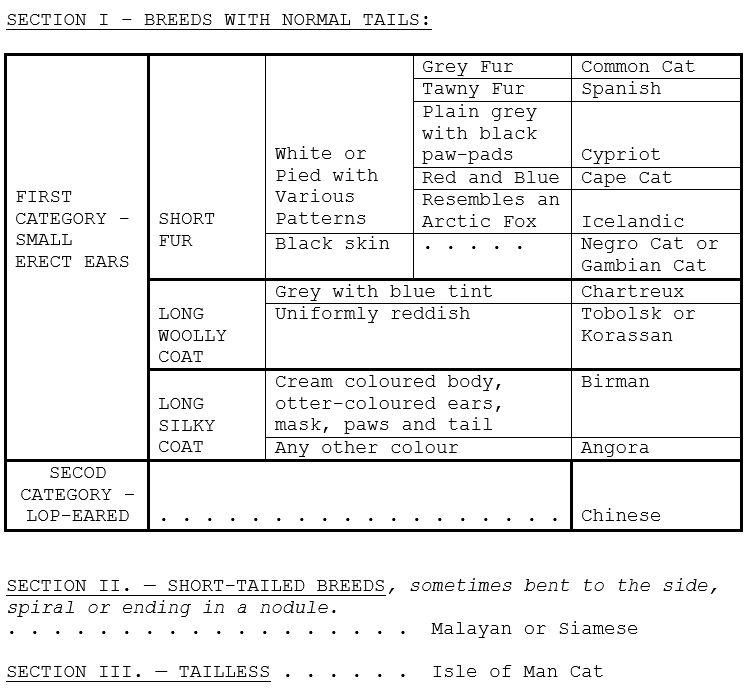
As a result of selective breeding and cat shows, a number of sub-breeds have been created, differing in colour and markings. Some of these sub-breeds have sufficiently fixed characteristics to be well-defined and standardised by the specialist clubs that regulate these amateur breeds. I will describe them by relating them to the races they are derived from.
THE WILD CAT.
The Wild Cat, also called the Gloved Cat (felis maniculata), Lybian Cat, Nubian Cat, and Egyptian Cat, lives in the African North-East, southern Tunisia by the Red Sea and in Arabia and Yemen. It seems to have been domesticated by the Egyptians, who used it (and even worshipped it) before the appearance of the Ichneumon or Pharaoh’s Rat (Herpestes ichneumon) [Egyptian Mongoose] which destroyed rats and mice.
The gloved cat must have gone to Europe. However, the question is very controversial. The Greeks and Romans ignored the cat as a domestic animal and used the stone marten to destroy rodents. The Tarentines and the Etruscans alone received cats from Egypt, considering them luxury animals and destroyers of mice.
The gloved cat may have given rise to the domestic cat.
Here is what the naturalist Tschudi, who had the opportunity to study the wild cat in the forests of the Alps, says about it: "Let us consider the wild cat to be the primitive strain of the ordinary cat, because the same essential structures are developed in both types and that it is impossible to attribute a different origin to the domestic cat, which, we must admit, lives also in the South, and has been found embalmed in Egypt.
Most strains of our domestic animals come originate in the Orient, not in France, so we would like the little Nubian Cat, to be the ancestor of our own cats. But this species is still not sufficiently studied, and it seems to differ from the domestic cat as much as the European wild cat. It is well known how much a thousand years of domesticity and a change of diet can modify the conformation of animals. In answering the question of origin, we attach less importance to the opinions of those who claim that tamed wildcats become indistinguishable from domesticated cats, and that domestic cats allowed to go wild revert to the same characteristics as the wild cat after three generations. The scarcity of observations does not provide a positive conclusion because it is difficult to know whether a captive wild cat has really mated with another captive wildcat. If a captive wild cat has mated, it is probably with a domestic cat so that the wild-domestic hybrids could easily return to the domestic type."
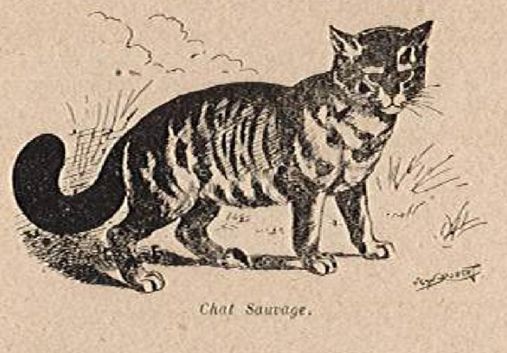
On the other hand, some naturalists claim that the gloved cat will not mate with the domestic cats and that it lived in a wild state alongside the Romans. If so, it is unlikely to be the ancestor of our domestic cat. We will not pursue this question of ancestry further as remains controversial. From the practical point of view it is of only secondary importance.
In truth, it’s known the world over, that while many animal breeds have undergone radical change, the feline type remains unchanged, even in its anatomy. This makes it difficult to create a family tree for the cat as has been done for the dog. Nevertheless I will provide a few lines regarding the wild cat.
Behaviour. - The wild cat lives in the great woods and especially in the high forests in the mountains. He is solitary and hunts at night. Climbing tall trees with amazing speed, he preys pitilessly and indiscriminately on small birds. He also attacks hares, rabbits and is especially fond of pheasants. It is not a great hunter of mice and rats.
He only rarely attacks larger animals, but he is known to occasionally attack fawns and small deer. On the banks of lakes and streams, he is a good hunter of fish and water-birds. But above all, it is a serious pest in parks and pheasant reserves, which it can depopulate in a very short time. Relative to its size the wild cat is a very dangerous carnivore. His bloodthirsty nature makes him kill many more animals than he can eat which is why hunters hate him and pursue him fiercely.
Habitat in Europe. - The wild cat is found in Switzerland, Germany, and France. It is not found in Russia, Sweden and Norway where it is replaced by the lynx. In France it is relatively rare. It is found especially in the forests of the Vosges, the Jura, the Haute-Marne.
According to the registry of the royal hunts found at the Tuileries after the time of Juillet, only one wild cat was killed in the forests of Rambouillet, Fontainebleau, and Compiegne, between the Restoration and 1830.
In Switzerland, few years go by without killing wild cats. Several have been killed in the canton of Zurich, including a 15-pound animal (Tschudi). According to Brehm, it is fairly common in the Thuringian forest to kill 13 in a single year (12 adult individuals and one 3 months old) by wounding the adult and destroying 3 young at the nest.
In winter the wild cat sometimes migrates long distances and even comes into villages when hunger makes it desperate. Lenz tells us that in Hungary the wild cat is much more abundant and often spends the winter in the barns. The wildcat lacks admirable maternal instinct found in the domestic she-cat.
Occasionally, the wild cat is hunted, but this is dangerous because a wounded wild cat will attack a man. Hunting is preferably done when it snows because it is then easier to follow the cat’s track and to find its den.
If the wild cat is caught off guard, he defends himself by fiercely attacking the hunter’s dog without provocation. He is so unafraid of dogs that he will voluntarily come down from the tree and attack them before the hunter arrives, resulting in a dreadful struggle. The angry cat rakes its claws into its opponent, making deep gouges, and tries to scratch its opponent’s eyes. It defends itself furiously for as long as it retains a spark of life and its defence is long because few animals have such a tenacious grasp on life.
In the Jura a male wild cat, lying on his back, held his own against three dogs and came out victorious from the battle. He slipped his claws into the muzzles of two of the dogs while he held the third by squeezing its throat in his powerful jaws. This mode of defence, which demanded extraordinary courage and an inconceivable skill, was at the same time a testimony to the cat’s extreme resourcefulness, for it was the only defence that could protect him from being bitten by the dogs (Tschudi).
Size. - The wildcat is bigger and stronger than the largest of our domestic cats, Generally it is 25 to 30 cm. tall and 42 to 45 cm. long.
Head. - The forehead is more convex than in the domestic cat, the neck is a little longer. The whiskers are longer. His teeth are stronger and sharper than those of the domestic cat, and his eyes are full of a ferocity not seen in domestic cats.
Tail. The tail is very characteristic; it is thicker and shorter than that of the domestic cat, and it is held low from the root to the tip.
Coat. - The wild cat’s coat is long and thick, longer and softer than that of the common domestic cats which have lived in our climate for several generations, but cats imported from Persia have longer hair than wild cats. The length of the fur helps make this animal look larger and bulkier than it really is.
Colours. — It should be noted that the coat colours are the same in all the individuals of this race, while they vary in the breeds of domestic cats. There are, however, some domestic cats whose coats are similar in colour to the wild cat.
The male wild cat is dark grey, the female is more yellowish, The colour is paler on the flanks and belly. Parallel black lines run from the forehead and backwards between the ears. A dorsal stripe runs along the spine from neck to tail and on either side of this stripe there are transverse stripes from back towards the stomach where they become pale and indistinct. The legs are yellowish with some black stripes around the thighs.
The tail, and this is a very distinctive feature, is regularly ringed, the rings becoming darker as they approach the tip. The face is a reddish yellow, the ears a reddish grey on the outside, white on the inside. The colour of the soles of the feet and lips is black.
Internal Organs. - Most of the internal organs are smaller than in domestic cats. In the wild cat, the intestines are only three times the length of the body instead of five times body length as in the domestic cat.
Reproduction. - The gestation period in the wild cat is about nine weeks, the young being born in April. The female makes a den in a burrow, a rock opening or a tree trunk and gives birth to 5 or 6 kittens that she nurses with great solicitude and then weans onto birds or rodents. Despite the care lavished on her young, she does not always defend them when a person takes them from her, so strong is her fear of man.
Linnaeus recounts the following on the topic:
"In 1865 a carpenter crossed a thicket about fifty paces from my house on the southern side of the Hermnustein, where there are a great number of rabbits. He thought he heard meowing from an enlarged burrow. This discovery filled him with joy, because a few days earlier he had expressed the desire to have some wild cat kittens. He began digging out the burrow and found three kittens each about the size of a rat. He put them in his sack and was leaving when he spotted their mother lying not far away with her ears erect. However, she kept her distance, and did not try to attack him.
She was the size of a large hare. The young, by their colour and short, thick tail, were easily distinguishable from domestic cat kittens. They were extremely wild, scratching, biting and screaming ferociously.
He tried all possible means of taming and caring for them, but in vain as they refused to eat or drink and fought him like devils until they died."
HARET CAT
The Haret cat is merely the wild cat and it should not be confused with the brown tabby domestic cat gone wild. Hunt masters refer to the wild cat as Haret Cat. (H. E. CHEVALIER, signatory of an article, on the Haret Cat in "Hunting Illustrated," October 24, 1868.
In a recent article, the Vicomte de SIMONY says that the name of Haret Cat undoubtedly came from the name given it by the Hebrews to Harets who belonged to the Tribe of Judas who owned a considerable number of cats. (Saltus Haret, 1 Book of Kings 22).
COMMON CAT (FELIS CATUS VULGARIS)
This species is much closer to the wild cat. It to be merely a less carnivorous variety, but has retained the wariness and predatory nature of its ancestors, and resembles them in its external characteristics.
Behaviour - This cat is not very sociable; abandoned to itself, it willingly retreats into the woods where its behaviour, and especially that of its descendants, reverts to the character and behaviour of the wild cat, but it is always distinguishable by its smaller size.
Size and Shape - This breed has a supple, graceful, well-proportioned body. The male is stronger and heavier than the female. Average weight is 4 kgs. The skin weighs 560 to 580 grams.
Head. – Of medium size; the nose is long and rather broad. The are ears small and erect, hairy on the outside, almost naked on the inside. The eyes are blue, orange or green.
Tail. - The tail is long, slender and short-haired.
Coat. - The coat is short, similar to that of the wild cat. The skin is white or pied depending on the coat colour. The lip and the soles of the feet are black. Each individual exhibits great diversity in the number of markings on the flanks and tail rings. The colour is not hereditary. Almost unsupervised matings produce the most diverse varieties of coat.
In the domestic tabby cat, there are small narrow, arched black bands on the head; the tail is long and ringed with black rings to the tip; there is a black line along the back, the legs are ringed with small transverse bands and on the thighs are five or six bands of the same colour. The colour and arrangement of markings makes it possible to establish a number of varieties or sub-races.
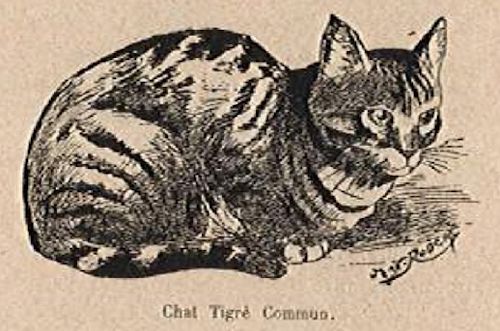
DUTCH CAT
(Variety of common cat, fixed by breeders.)
Colour.- Black-and-white, blue-and-white, orange-and-white or cream-and-white. Each colour is delimited and has no other colours present.
Markings. - The single colour (i.e. black, blue, cream or orange) starts just behind the shoulders and stretches around the body, extending onto the tail and hind limbs. The ends of the hind legs are white. The ears and the mask must be the same colour as the hindquarters.
The white colour is on the shoulders, neck, forelimbs, feet, chin and lips. A white line runs between the ears to the back of the head where it joins with the white on the neck, and divides the head into equal two parts. These sought-after markings match those of the Dutch Rabbit.
Eyes. – Copper, orange or amber for black-and-white cats and also for blue-and-white cats; brown, orange or amber for orange-and-white cats and cream-and-white cats.
Body and Tail. - The animal stands low on its legs. It is well-muscled with a deep, wide chest, the tail continues almost as an extension of the dorsal line, thick at the root and ending in a point, moderately long and slightly curving towards the tip.
Leg and Feet. - The legs are rather short than long, well-muscled, feet rounded.
Head and Neck. - The head is broad between the ears, the cheeks are well developed, the face and nose are short, the head is set on a thick, short neck.
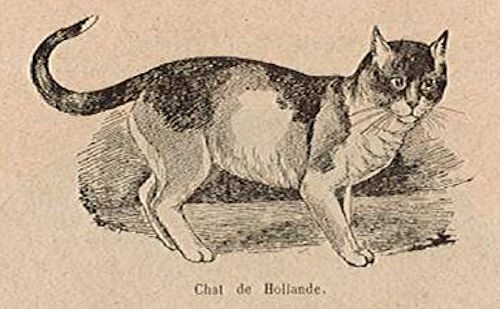
Ears. - Small and round at the tips, facing a little forward, not too large at the base.
Hair. - The hair is always very short.
Scale of Points:
Colour: 20
Markings: 25
Eyes: 5
Body and Tail: 15
Legs and Feet: 5
Head and neck: 10
Ears: 5
Coat: 5
Total : 100
We include a schematic drawing of an animal of this breed with the most popular markings.
SPANISH CAT
The Spanish or Portuguese Cat is designated Felis catus maculatus by Linnaeus and Boddaert.
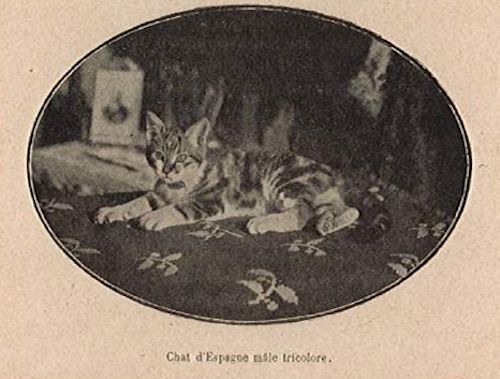
Behaviour. This cat is generally soft and affectionate, very attached to the owner. It is an even-tempered cat, but also a very effective mouser.
Habitat. — Although originally from the Iberian Peninsula, this breed is now found all over Europe.
Size. - These cats are noticeably smaller than common cats.
Coat - The shiny coat is short. The male is tawny coloured, paler on the sides and underneath, or is fawn marked with white. The female is fawn marked with white and black. The tip of the nose, the lips and the paw-pads are pink. There are rare reports of exceptions to this sexual differentiation of colours. I present here a picture of a male tricolour cat which belonged to M. Chatelain de Morunz, Neufchatel (Switzerland) in 1913. Around the age of 5 months the yellow colour faded a little but the fawn, black and white colours persisted. Morphologically well constituted from a general point of view, but it should be noted that none of its matings resulted in any offspring.
ISLE OF CYPRUS CAT
Also called Cypriot cat. This breed is found almost exclusively on the island of Cyprus. It was formerly employed by the monks of the island to kill snakes.
Coat. - The coat is short and light grey. The paw-pads are black. The skin is white. There are some members of this breed that have long hair.
Ears - The ears are small and erect.
CAPE OF GOOD HOPE CAT
It is a little-studied breed found in the southern part of Africa.
Coat. - Short coat, red and blue in colour. Those with blue fur have a reddish dorsal line.
Ears. - Small and upright.
Tail. - Medium length and reddish colour.
GAMBIAN CAT
The Negro or Gambian race is found in Gambia, Guinea and on the West Coast of Africa.
Size and Shape. - The body is little bigger than that of the common cat, but the legs are much longer, which gives these cats a distinctive look.
Coat. - The coat is blue grey with short hair. The skin is black and wrinkled. It cannot mate with the European cat.
Tail. - The tail is tapered with no nodules.
CHARTREUX CAT
The Chartreux Cat, (félis catus carthusianorum) is fairly rare in England and France, but is quite common in many other countries, especially in the United States, where it is called the Maltese cat. This beautiful animal is widespread in the mining districts and agricultural regions, far from the inhabited centres.
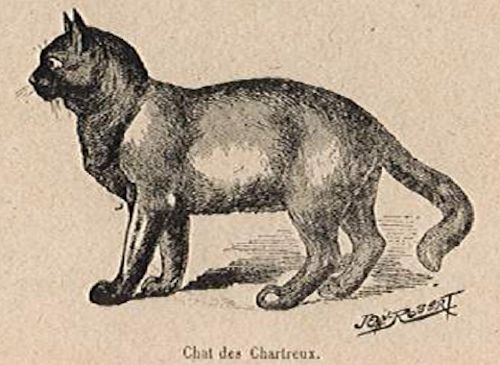
It is also found in Russia where it constitutes the sub-races of Tobolsk, Korossan and the Caucasus.
It is one of the races which can live in the low temperatures of the higher mountainous districts. This is where they are taken from before taking them into Russian territory. Their lives go from one extreme to the other; during the brief Russian summer, they roam the forests infected with poisonous insects; in the winter, they are imprisoned within the four walls of a snow-covered cabin, and forced into domestic service, until the thaw drives them out. Many of the beautiful furs that come to us from Russia are actually the skins of those cats, there is a large and prosperous industry in preparing these for the market.
Behaviour. - The Chartreux has a general tendency to be lazy, however, it is a good hunter of mice and small birds.
Size. – Strongly built, handsome, with well-proportioned limbs that blend well with the rest of the body.
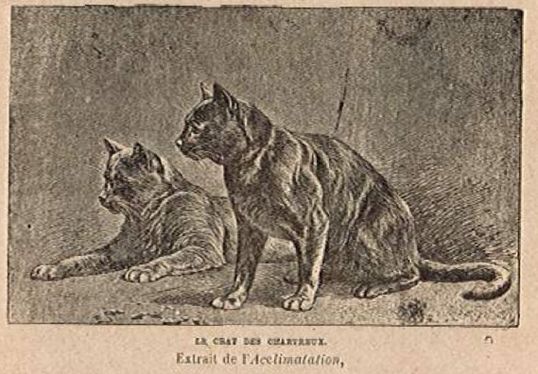
Tail. – This appendage is normal, of equal size along its length, without knots.
Head strongly built, with large full eyes, small erect ears, short nose.
Coat. - Semi-long, woolly coat, this woolly consistency forms the main characteristic of the breed; it is even found in individuals whose hair is not very long.
Colour. - Uniform grey colour with bluish reflections in the Chartreux breed proper, reddish in the Tobolsk variety.
Scale of Points:
Size: 20
Tail: 5
Head: 10
Coat (woolly texture): 25
Colour: 25
Ensemble: 15
Total: 100
TOBOLSK CAT
This race, described by Gmelin, exists in Siberia, and is sometimes called the red cat of Tobolsk.
Size and Shape. - It is larger than the common cat and similar in conformation to the Chartreux.
Head. - Robust with large eyes, fairly short nose and small, erect ears.
Coat. - As befits an animal from cold countries, the Tobolsk cat has a long coat, longer than that of the Chartreux. Its consistency is woolly and is uniformly reddish.
BIRMAN CAT
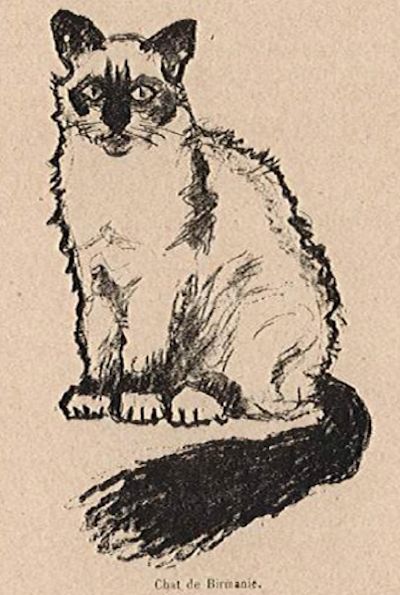
Size. - These animals have elongated bodies, slender, well-proportioned legs. The weight in adulthood varies between 3 and 4 kilogr.
We give below the weights observed on two male subjects.
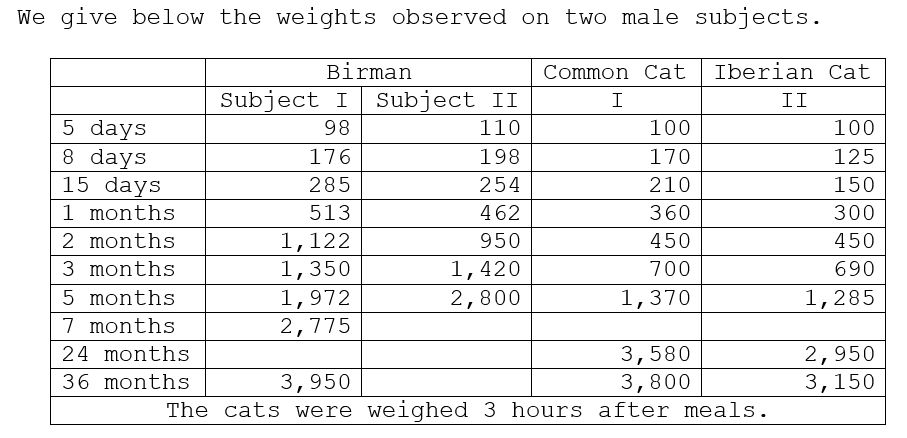
Head. - The head is long with large, erect ears covered with felted hairs; the forehead is rounded. The males have a bushy, cream-white forelock between their eyes, which covers them oddly like a griffin. The whiskers are thick and long. The eyes are intense royal blue, very mobile.
Coat. - The fur is the same length as the fur of the half-Angoras [domestic longhairs/half-bred Persians] and separates along the back as though by a comb. The colour is that of a creamy white Siamese, with perhaps, more golden tones. The mask, tail, ears and legs are dark otter-brown, the four legs are terminated by a white glove which ends below the wrist.
The tail has no knots or nodules; it is long, covered with fur to form a plume, and carried aloft in the manner of a squirrel.
Reproduction and breeding. - The breeding of the subjects we observed was particularly difficult. Ms. Leotardi, who has had the opportunity to breed several litters, says that we should not expect to raise more than one in ten kittens. Regarding food, these animals find boiled fish and cooked salad very good; others will only accept raw meat.
Here is the scale of points established for the appreciation of these animals’ beauty.
Scale of Points:
Coat (length and texture of hair) 20
Colour and markings - 20
Head - 15
Eyes - 15
Tail - 20
Body - 10.
Total - 100.
ANGORA CAT
The angora race or more precisely the Angora breed originates from the Angora region of Anatolia. This Persian region of Angora has been recognized as a remarkably promoting the fur and the fleece of all breeds born in its climate, and the name "Angora" has become attached to any hairy cat with a long, thick silky coat. These cats are quite common in Turkey and Armenia, and there are some fine samples in England and France.
Behaviour. - The Angora cat has an indolent, frivolous character; he is lazy, sleepy and lacks the carnivorous instincts of felines. Rarely does it hunt mice, rats and other small mammals. His intelligence is, however, highly developed.
Realizing that it is a subject of luxury, the Angora is fond of soft cushions, armchairs and, resting motionless for hours in living rooms, it seems to be part of the objects of art collected to indulge the privileges of wealth.
Owing to his indolence, he moves slowly, grows fat easily, meows little and sleeps much more than other breeds of cat.
Size, shape and coat. - The Angora’s size is below average: it is large without being too coarse, generally fat. The legs are short. The hair is long, fine and silky, especially in the region of the neck, stomach and tail. If the fur is woolly and the coat too heavy, it indicates an animal that has already undergone several crossings in its ancestry. This remark does not apply to neutered individuals, which after castration thicken, accumulate fat and whose hair undergoes a transformation which makes it less silky.
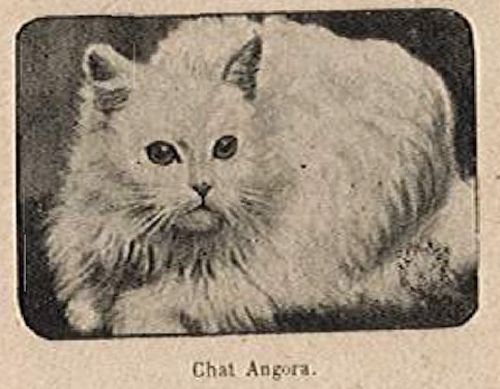
The Angora's hair deteriorates and changes when these animals leave their country of origin. This peculiarity can be easily observed in cats imported from Persia. However, with care, we can manage to restore all the original silkiness of Angora fur to cats born in England or France.
Head. - This must be round, broad, with a short, light pink nose. The ears are large rather than small, with a tuft of hair at the pointed tips. The eyes, which are large and expressive, vary in colour according to that of the coat, they are blue, grey or orange.
Colour and Markings. - Originally, the real Angora cat had splendid white livery and blue faience eyes; but, over the centuries, the changes brought about by domestication and the emigration of oriental breeds into Europe, have caused the colour to vary and even in Persia it is nowadays very rare to find the original type. There are few individuals that show the characteristics of the pure Angora; uniformly single-coloured coat, sky blue or golden eye.
The colours are:
1. - snow white.
2. – jet-black and black with mahogany highlights. The latter seems scorched by the heat of the sun.
3. - the blue shade, known as Persian Blue in animals (see the detailed description in a special chapter),
4. - tawny colour. The fawn angora is considered to be common in Persia and is, therefore, little appreciated. However, its fur is unimaginably rich in tone and under the glare of the sun this golden fleece becomes dazzling and wonderful.
Here is the Angora Standard used by C.C.F. judges.
Colour and Markings. - Permitted colours:
1. - white.
2. - black.
3. - blue.
4. - fawn.
The fur should be a uniformly single colour without any mixing.
Silky coat, long, abundant hair, especially in the region of the neck, stomach and tail.
Size and shape. - The cat must be large without being too coarse, but it must be fleshy and have short legs.
The head should be long and broad, the nose short, the ears large and pointed with a tuft of hair at the top, the lips flesh pink.
The large, expressive eyes should be: Blue or orange with the white coat: 2. —orange with the black coat; 3. - orange with the blue coat; 4. - blue or orange with the tawny coat.
Scale of Points:
Colour - 25
Coat - 25
Size and shape - 20
Head - 10
Eyes - 10
Beauty, overall quality - 10
Total - 100
BLUE PERSIAN
The Blue Persian is a variety of Angora characterized by the shade of the coat. It is native to Asia Minor where it is nevertheless quite rare. The cats imported into France and especially into England come from caravans which, twice a year, cross all of Persia and go to Bombay to sell horses and other commodities.
Behaviour. - These cats are quite sociable. The castrated specimens become fat and very indolent.
The size is generally larger than the white Angoras.
The head is large with slender, erect ears covered with felted hair. The face and nose are short. The head is surrounded by a very thick ruff. The tail is normal, without knots, not tapered, of medium length and covered with long fur.
The coat is long and silky, and long fur covers the legs and even the feet.
The colour is blue, but there are many varieties and by selective breeding you can get just about any shade of blue. All shades are allowed on condition that there are no white hairs and that the shade is uniform.
The Clubs concerned with the Blue Persian are: in England, the Blue Persian Cat Society, founded in April 1901; in France The Club François du Chat Bleu de Perse (affiliated with the C.C.F.) founded in 1914 and there is an American club specializing in the breeding of this variety.
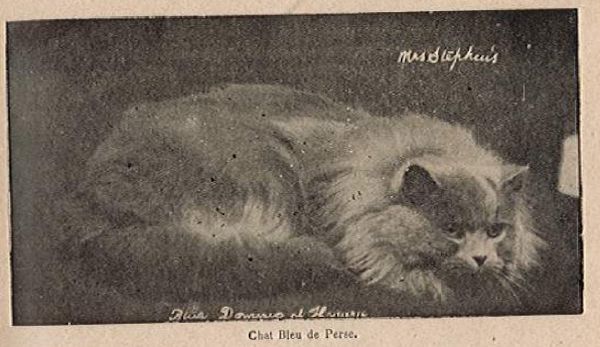
Here is the Standard of the Persian Blue cat adopted by the French exhibitions by the judges of the C.C.F.
Coat. - All shades of blue are allowed: solid and well-defined colour, without markings, shading, or white hairs. The coat must be long, thick and soft to the touch, the ruff very abundant.
Head. – Large and round with space between the ears. The face and nose are short. Ears thin and covered with close-lying fur. Well-developed cheeks.
Eyes large and round, orange in colour.
Body cobby and set low on the legs.
Tail. – Short and fluffy, not tapering.
Scale of Points:
Coat – 30
Head – 25
Eyes – 20
Body – 15
Tail – 10
Total - 100.
TORTOISESHELL CAT
This breed is a variety of long-haired cat that originated in England as a result of selections made by cat lovers in the United Kingdom.
Behaviour. - Luxury animals, specimens of this breed are generally quite indolent and not well suited to chasing mice.
Size and shape. - Large in size, robust without being fat, set low on the legs, all of which constitutes a graceful and elegant whole.
Large, round head, short nose, small, well erect ears. The eyes are large, round, full, brown or bright orange in colour.
Colours and markings. – In general black and orange. However, three colours are allowed: black, orange and yellow; these colours should be as vivid as possible, without any stripes or white markings, which distinguishes the tortoiseshell cat from the Spanish cat.
Tail. - Long and thicker at the base.
Coat. - The fur is silky, soft and very long.
Scale of points.
Colour - 30
Coat - 20
Size and shape - 20
Head - 15
Eyes - 5
Overall impression - 10
Total – 100
The term tortoiseshell is also given to short-haired cats exhibiting the characteristics described above. In this variety we sometimes find specimens that have white forelegs and breast, and a white patch between the eyes, extending like a blaze down to the muzzle.
CHINESE CAT
The Chinese cat (felis catus sinensis) is reminiscent of the Chartreux by the length and texture of its fur. It is found in China in the province of Pet-chi-li and throughout Manchuria. There it is fattened and eaten like chow-chow dogs.
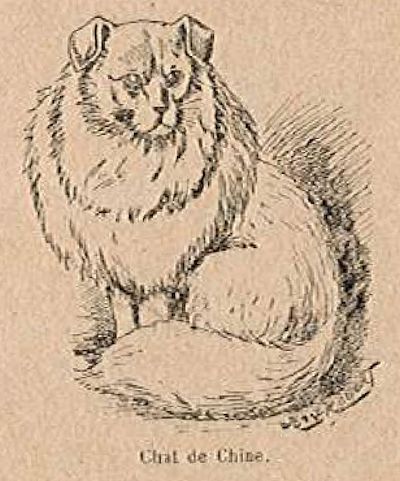
When it is plump, it appears next to the swallow’s nests on well-served tables.
The Chinese cat is also used as a commodity for export and trade between the Manchus and the inhabitants of the land of Kiliaque in return for sable furs; but the Chinese are careful not to hand over any females.
It seems that the Chinese use the cat as a sundial. In fact, Father Hue spoke of a method employed in some provinces of China to know the hour by means of careful examination of the cat's eye.
"Our adept neophytes," he said, "brought three or four cats, and explained to us how a cat could be used as a watch. They made us see that the pupil of his eye narrowed as we approached noon, at noon it was a perpendicular slit on the eye, and in the afternoon it began to dilate again. When we had examined all the cats attentively, we concluded that it was past noon – all their eyes were in perfect agreement."
Baudelaire also took notice of the Chinese Cat and wrote the following lines in Revue Fantaisiste in 1861:
"One day a missionary walking in the suburbs of Nanking realized that he had forgotten his watch and asked a little boy what time it was. The boy of the Celestial Empire hesitated at first, then, turning his back, he replied: ‘I will tell you.’ A few moments later he appeared, holding in his arms a very large cat, and, looking at the pupil of the cat’s eyes, he said without hesitation: ‘It is not quite midday yet.’ Which was true. For me, when I take in my arms my extraordinary cat, which is at the same time the honor of its race, the pride of my heart, and the perfume of my mind, whether at night, In the full light, in the depths of her adorable eyes I always see the hour distinctly, always the same, an immense solemn hour, great as the space without division of minutes or seconds, a motionless hour which is not marked on the clocks and, however light as a sigh, quick as a glance.
And if some intruder came to disturb me while my gaze rests on the delicious dial, if some dishonest and intolerant genius came to tell me ‘what are you looking at with such care?’ What do you look for in the eyes of this stranger? Do you see the hour, mortal prodigual and lazy?
I would answer without hesitation:
Yes. I see the hour; He is eternity!"
Size and shape. - In size, it is much larger than the common European breed.
Head. - The head is rather large, with drooping ears, not erect.
Tail. - Thick, of medium length, without knots or breaks.
Colour. - Black or yellow with markings on the sides, black on the head, white above the eyes.
Coat. - The coat is semi long and silky.
SIAMESE CAT
This breed is native to the Far East. It is found in Siam, the English Indies, and the Malay Archipelago. In Europe, there are now quite a few imported specimens or specimens born in England or France.
Behaviour. - These cats are very intelligent and training is easy. They can be taught to open doors and cupboards as well as acrobatic tricks. Very attached to their master, they follow him like little dogs, but it should be noted that they are greater thieves and more independent than other domestic cats.
Regarding the intelligence of these animals we give below a comparative table of the weight of the nervous centres in the Siamese breed and in the common and Iberian breeds.
Weight of the Nerve Centres of Siamese cats compared to those of other breeds.
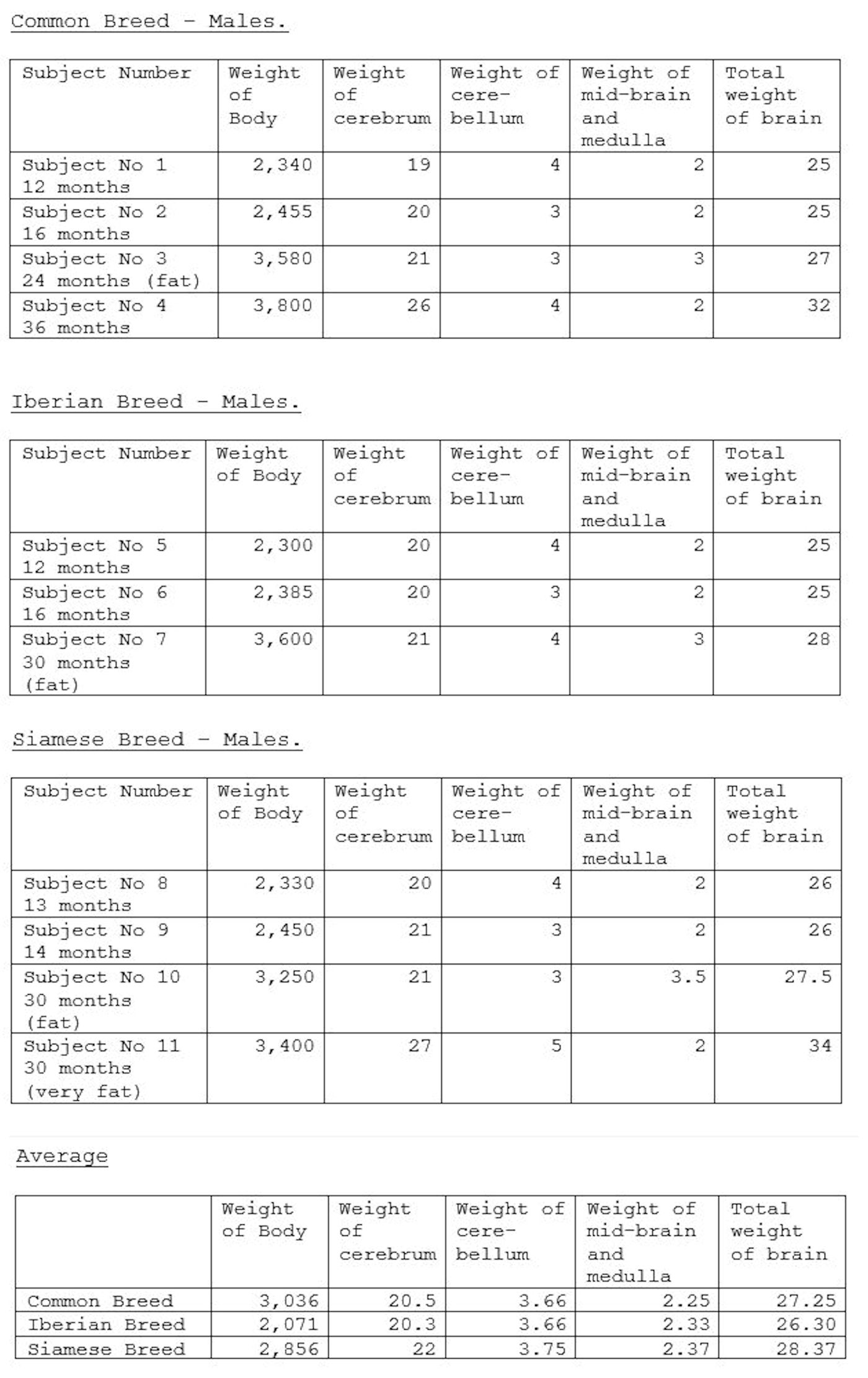
By comparison among other subjects of the same race, same age and more or less similar conditions of overweight, we see that in general the brain is much more developed in the Siamese race renowned for its intelligence.
Siamese cats are particularly sensitive to the action of cold, which profoundly modifies their level of activity. During the winter the Siamese falls into a state of dullness which, while not always very apparent, is nonetheless very real. This state of dullness greatly reduces the resilience of young and adult subjects.
On this subject we noted the temperatures of the same subjects in summer and in winter:
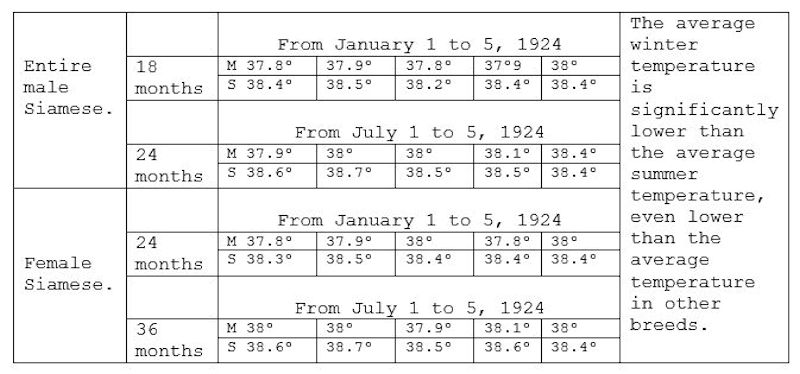
In the Siamese more than 80% of illnesses are observed during winter. Because of this cold-sensitive disposition, a constant minimum temperature of 20º must be maintained in the breeding premises, which can be reduced to 15º for those closer to adulthood. Fatalities are frequently observed and are to be feared below this temperature.
This sensitivity to cold is the cause of many accidents during rail transport, and unaccompanied journeys should be absolutely prohibited during winter.
However, there are exceptions, hence Mme la Marquise de Scey Montbeliard, whose cattery is located in Haute Marne, reported the case of a very beautiful 9-year-old male (weighing more than 4.5 kg.) who spent his nights outside in the snow and 20º of cold.
Siamese cats eat mainly fish and boiled rice, but they are great hunters and devour their prey - sparrows, mice and rats - which they are very fond of.
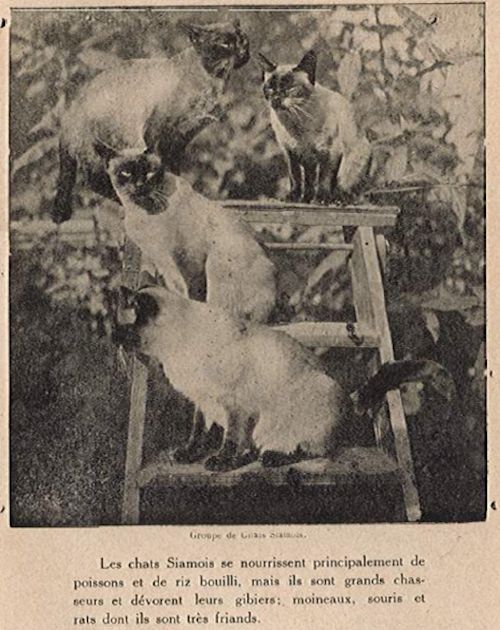
They have a wide vocal range, and they use it with different and modulated intonations, especially during the period preceding the mating. At this time the females make cries that resemble those of wildcats.
Size and shape. - They are generally smaller than our European cats. The male is noticeably larger than the female. The profile is a rather long, but elegant and graceful. The legs and neck are thin.

Head. - Always small, wide between the two eyes, tapering between the ears. The forehead is flat and receding, the nose is long and rather broad, the lips are rounded and full, the ears are quite large and broad at the base with sparse downy hair inside. The eyes are almond-shaped slanting towards the nose, the iris is a greenish blue; these eyes take on almost red hues when the animal is irritated or frightened.
Tail. - Shorter than other European cats, it is either straight and slender like that of a pointer dog, or short, curved, broken and even twisted like that of the pig. At the base, there is almost always a knot, which is one of the characteristics of the breed.
Coat. - The coat is short, soft and silky to the touch. On the face, legs and tail, they are shiny and glossy. The coat should lie flat on the body, showing the hard and firm muscles, because the Siamese cat should not be too fat.
Colour. - Adults have a solid background colour; light café au lait, pale silvery grey, light orange, or bright fawn are the preferred colours, but the lighter colours are most popular; the belly and the underside of the animal are always lighter, the back being darker. The head (in whole or in part), tail, and all four legs are dark brown, and the blue eyes stand out against the dark mask. The hairs lining the inside of the ears are white as down. There is often a white patch on the front between the neck and chest; any other white spot is a disqualifying sign. The hairs of the long whiskers and those of the eyebrows are very light. Adults have a brush of hair, similar to whiskers, on the forearm. Usually, in the umbilicus region, there is a blackish patch that stands out well on the very pale coat in that area.
Reproduction and Breeding.
For a long time, the number of kittens born in Europe was very small because the King of Siam, very jealous of his breed of cats, did not allow entire males to be exported. Siamese cats cannot mate without extreme danger, as Siamese kittens are born much smaller than those of other breeds. It should be noted that the female gives birth about a week later than other female cats and the gestation period is generally 65 to 66 days.
The crosses obtained from mating a Siamese male and common female generally produce only common breeds. In ten observations of such crosses, I only once found a case where a kitten had the broken tail as a result of a Siamese mating with a common cat. At the Marseilles cat show in 1925, I saw a long-haired cat with the colour of the Siamese breed. Its tail was shorthaired and didn’t have any nodules.
The litter size varies between 2 and 6 kittens, with 5 being usual. This average figure is based on 38 observations collected by 7 French and Belgian breeders of Siamese cats.
From the age of 4 years the number in each litter decreases and does not exceed four on average (personal observations by Mme. Marquise de Saint-Mars).
Siamese kittens grow rapidly while they live on the mother's milk, but there are individual differences in the growth of animals in the same conditions.
Growth is much less rapid in kittens which, instead of receiving the mother's milk, are given a different diet. The same phenomenon has been observed in kittens entrusted to foster mothers of other breeds. In several cases we have observed complete dieback and 80% mortality.
As an indication, we give below the table of weights observed in cats of the common breed and in Siamese cats.
Cats were weighed three hours after meals.
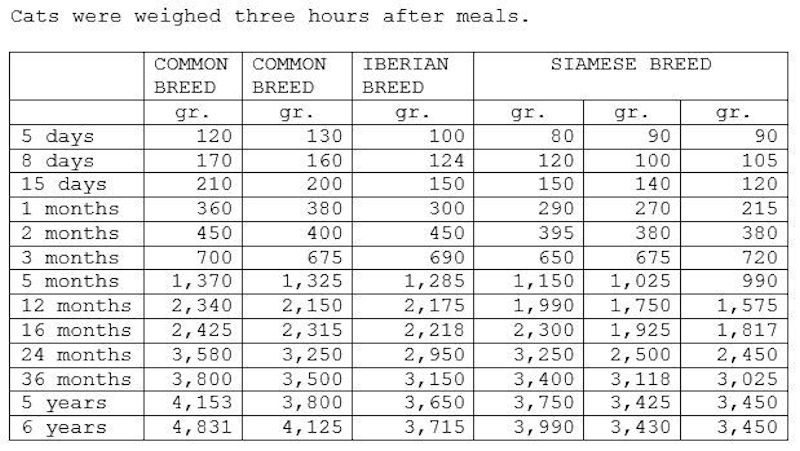
The young are born white with a small dark line on the edge of the ears. If, at birth, there is the slightest stain on the immaculate coat, they should not be kept because they are not purebred.
Siamese cats are reputed to be difficult to breed; this is incorrect and Mme Marquise de Ligneries who has raised more than ten, tells us that there is no more danger than with other breeds. Be careful not to overdo raw meat: it is good to mix it with bread or with the cooked rice that they prefer; give plenty of milk as a drink and keep clean water available for the kittens.
Clubs.
In France we currently have a large number of Siamese cat breeders, grouped into a club: the French Siamese Cat Club (affiliated with C. C. F.) and in England there is the Siamese Cat Club (affiliated with the National Cat Club).
To conclude we give below the Standard and the scale of points adopted for the use of the judges:
Body Colour: - Must be as pale as possible and preferably cream but a tawny shade is also permitted. There must be no stripes, spots or markings on the body. The mask, ears, paws, and tail have very distinct otter-brown markings. The mask is separated by a faint line (like that of kittens) and must have no markings or visible lines. The general appearance depends very much upon a good mask that resembles, as much as possible, the face of the marten.
The eyes must be a brilliant blue and lively.
Hair is lustrous and lying flat against the body.
Form: - The body must be rather long, legs slim, well proportioned.
The head must be long and pointed.
General Appearance: - Must retain the following features: something curious and eye-catching. It is important that the specimen is not too large, which would detract from the much-appreciated slender type. In summary, each of these peculiarities of the Siamese cat must be the opposite of the domestic cat, retaining the contrasting colours and the knot on the tail that particularly distinguishes it.
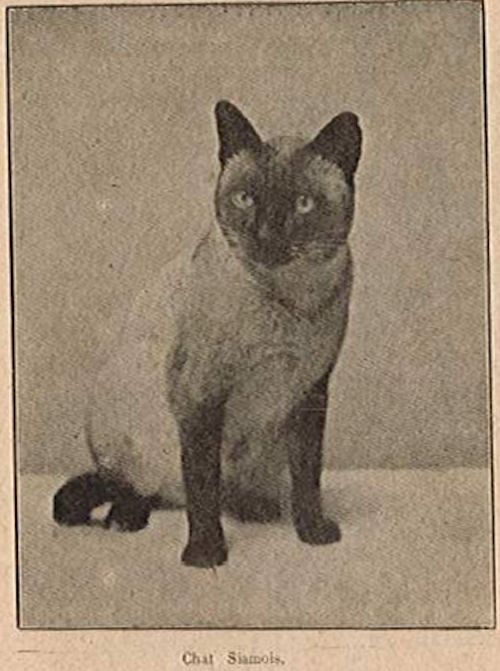
Note: - While it is commonly accepted that blue, black, white, tabby and other colours are found in cats from Siam, the Cat Club of France admits only those who meet the above Standard exactly.
The points of the Chocolate Siamese Cat are the same as those above, except for the body which has a particular colour.
Scale of Points:
Body colour - 20
Size - 10
Coat - 10
Head - 10
Eyes - 20
Mask - 15
Harmony of Points - 15
Total - 100
Any cat that does not get, at each shows a minimum of 75 points, cannot aspire to championship status in the Cat Club de France.
TAILLESS CAT
This breed of cat currently originates from the Isle of Man in the Irish Sea; but it is very likely that it was imported from the Far East, Japan or China, the neighbouring countries of Malaysia, the home of short-tailed cats. Japanese or Chinese paintings, in which tailless cats are often seen, confirm this opinion.
Currently, this breed is especially widespread in England, but very rare in France.
Behaviour. - These cats are very friendly, attached to their master, and very good at hunting mice; they feed preferably on meat.
Size and shape. - A little above average size, the body is as short as possible. The hind legs are higher and stronger than the front ones, so that the animal no longer runs like a cat, but like a rabbit.
The head is large and fine, not pointed. The eyes are large, round and full, like common cats, the medium ears are slightly rounded at the top. The eye colour varies: it is orange, golden yellow or brown, depending on the colour of the coat; always orange with a black coat.
Tail. - The Isle of Man cat does not have a tail, and this is the main characteristic of the breed. There should not even be the semblance of a tail stump.
Colour. - This is very variable, however, we do not know of any whites, and blacks are very rare. It is generally speckled silver. Madame Marcelle Adam recently observed a little tailless cat from the Island of Formosa, blond tortoiseshell, green eyes slanted in a black mask.
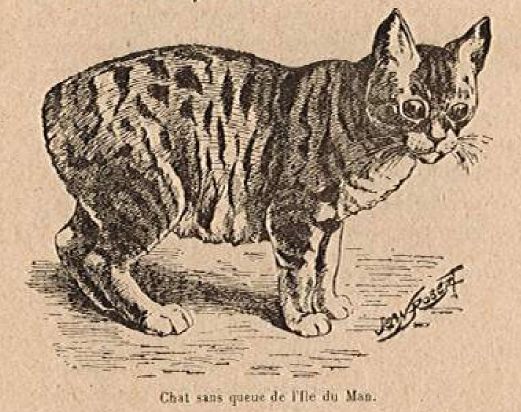
Coat. - The fur is semi-long, especially the top coat; the undercoat is slightly cottony and soft to the touch like that of a rabbit.
Scale of points.
Body and legs – 25
Head ears and eyes – 10
Coat, consistency to the touch – 25
Absence of tail – 25
Overall appearance – 15
Total - 100.
CONCLUSIONS
The breeding of purebred cats is developing more and more in France and acquiring a real importance; it is to be hoped that the Superior Committee of Genealogical Books regulates the standards of the cat breeds that exist in France.
The breeding of cats is, in fact, like that of dogs; because it generates wealth it is in our interest that English, Belgian, etc. breeders are not allowed to ruin or monopolize them, the latter are currently exporting a large number of specimens to France at inflated prices.
SEEN:
Director of the Veterinary School of Lyon,
F. X. LESBRE.
Professor of the Veterinary School,
H. BUTCHER
SEEN:
Dean,
J. LEPINE.
President of the Thesis,
Dr F. ARLOING.
Seen and given permission to print: Lyon, February 12, 1925.
The Rector, President of the University Council
J. CAVALIER.
V. CHAILAN Printing
Saint - Raphael (Var)